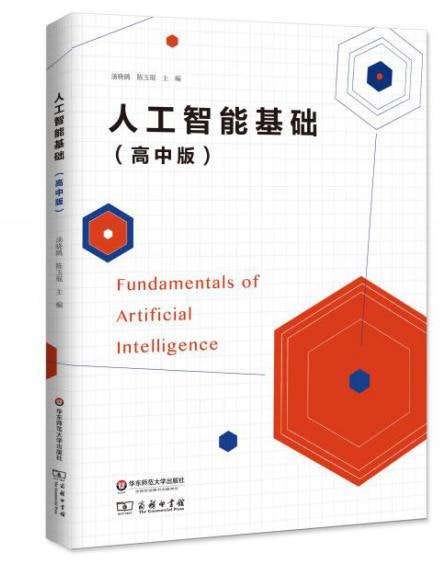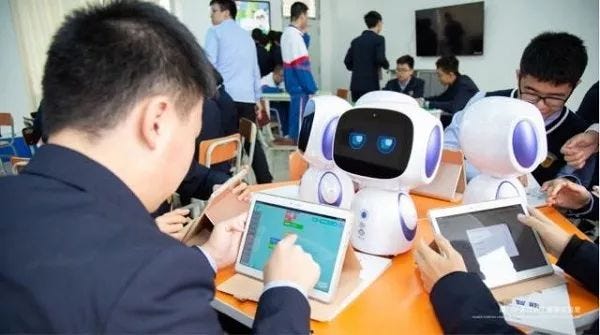China’s Governmental Strategy and School-Enterprise Cooperation on AI Education

In 2013, Britain became the first country in the world to incorporate computer programming into the curricula of compulsory education. In 2016, the U.S. government put forward the “National Computer Science Education” program to carry out K12 programming education. Following the steps of both, the Chinese government has recently launched a series of development plans for Artificial Intelligence. In July 2017, the State Council issued the “New Generation of Artificial Intelligence Development Plan”; in December 2017, the Ministry of Industry and Information Technology released the “Three-year (2018–2020) Action Plan for Promoting the Development of the New Generation of Artificial Intelligence Industry”; on March 5, 2018, the government work report mentioned “intelligence” four times. All these fully reflect the determination and motivation of China to actively develop artificial intelligence, as has been manifested in the recent development of AI-related policies for both secondary and tertiary education.
New Curriculum Standards for Senior High Schools
In August 2017, the State Council promulgated the “New Generation of Artificial Intelligence Development Plan”, which clearly stated to aim at “the implementation of the National Intelligence Education Project, setting up courses related to Artificial Intelligence in primary and secondary schools”.
In January 2018, the Ministry of Education in China promulgated the “Curriculum Standards for General Senior High Schools and Chinese and Other Disciplines (2017 edition)”, formally incorporating AI, Internet of Things and Big Data Processing into the new “Curriculum Standards for Information Technology Courses in General Senior High Schools”, and establishing the two modules of “Data and Computing” and “Information System and Society” as compulsory courses. The module of “Data and Computing” aims to help students: understand data coding, and learn to collect, analyze and visualize data; learn a programming language, and use the programming language to complete simple algorithms; understand the importance of artificial intelligence. The new curriculum standards greatly reduce the requirement of using basic software, and instead greatly elevate such requirement as thinking with programming, calculation and algorithms. As far as AI is concerned, in addition to the requirement for understanding the development of AI and the implementation process of algorithms, students are also asked to build simple application modules (such as machine learning, automatic translation, face recognition, automatic driving, etc.) through project-based learning, and design and implement simple intelligent systems by using open source hardware.

In April 2018, the textbook “Fundamentals of Artificial Intelligence (High School Edition)” for AI education in high schools was published in East China Normal University in Shanghai, China. This is the first ever AI textbook introduced into China’s secondary education system. The textbook is co-edited by SenseTime, an innovative technology company dedicated to computer vision and deep learning technologies, and East China Normal University. Teachers from various prominent highs schools in Shanghai also participated in compiling this textbook. Forty schools in total in China have been selected as the first batch of “experimental bases for artificial intelligence education” to accumulate experience for the development of artificial intelligence education.
In March 2019, the Ministry of Education of China announced the “Key Points of Education Informatization and Network Security Work in 2019”, proposing to assess the information literacy of 20,000 students at primary and secondary schools in order to promote the establishment of courses related to artificial intelligence in primary and secondary schools, and to gradually promote programming education.
New Majors for Undergraduates
Regarding higher education, Chinese universities have also responded positively to the policies of the Chinese government to provide AI-related education. In 2016, only 32 universities in China offered majors related to data science and big data technology, while 2017 saw 250 colleges and universities offering the major of “Data Science and Big Data Technology”.
In April 2018, the Ministry of Education in China laid out the “Action Plan for Artificial Intelligence Innovation in Colleges and Universities”, which clearly proposed to build a hundred “Artificial Intelligence + X” (with X standing for a non-AI major) compound majors by 2020. By 2020, fifty AI departments, research institutes or inter-disciplinary research centers will have been established; by 2030, universities will have become the core force in building the world’s major AI innovation centres and the talent pool in leading the development of a new generation of AI. Meanwhile, the plan also mentioned the construction of a team of supervisors in AI education, requiring the establishment of AI-related knowledge and skills courses for them.
In March 2019, the Ministry of Education of China announced the “Results of the Filing and Approval of Undergraduate Majors in General Institutes of Higher Education in 2018”. Artificial Intelligence has been added to the list of newly approved undergraduate majors offered by Chinese colleges and universities for the first time. Thirty-five universities, including prominent ones such as Shanghai Jiaotong University, Tongji University and Zhejiang University, have obtained licenses for offering undergraduate majors in AI.
New Opportunities and Problems in School-Enterprise Cooperation
The governmental policies in AI education have brought new opportunities for school-enterprise cooperation. On the one hand, the main driving force of AI technology at the moment lies in the private sector while different players excel in their own fields of AI application. Among them, Baidu Autonomous Driving, Alibaba City Brain, Tencent Medical Imaging, iFlyTek Speech Recognition System and SenseTime Intelligent Vision together constitute five National AI Open Platforms. Therefore, the implementation of AI curriculum in schools has much to do with those Tech giants with cutting-edge technology.
On the other hand, schools are lacking a wide range of resources to incorporate AI-related contents into current curriculum by themselves. In China’s primary and secondary schools, teachers who understand AI are in great demand. Most primary and secondary schools only have 1–2 IT teachers for each grade. Thus, school-enterprise cooperation has become an important way to meet the great need of talents in artificial intelligence. Enterprises can build AI courses with schools, set up scientific talent training systems and syllabuses, and participate in the construction of school laboratories and the supportive environment. Also, by providing certain data and delegating problems to students and professors, the enterprises can integrate industry experience with schools organically, thus providing the academia with opportunities of contributing to the industry.

But business involvement is a double-edged sword. Allowing enterprises to participate in the development of AI education has also led to some new problems, especially in primary and secondary education. In addition, aligning with the New Curriculum Standards which stated clearly that teaching AI in schools should be backed up with a suite of hardware system, building AI-related labs is on many schools’ radar. But how? The budget for the construction could easily climb to millions of RMB. And it’s also time-consuming. Teachers and educators start to hold some pushbacks regarding this aspect.
First, although the new curriculum standards have been issued, they are too vague to serve as references for what and how AI courses ought to be taught for schools, teachers and enterprises. A teacher told JMDedu that educators have not been impressed by AI-related educational products on the market because they “can’t answer one question: What can students learn from a course when the AI curriculum standards are not clear yet? AI courses are akin to those in liberal arts in that no one can define or measure the importance of the AI technology or of the enhanced abilities of students.” Besides, it is difficult to effectively quantify the improvement of students’ abilities as a result of learning AI, creating dilemmas for both schools and enterprises: on the one hand, it is difficult to demonstrate the school’s teaching quality without quantified results, while the improvement of students’ abilities should not be evaluated by quantified results alone; on the other hand, enterprises are unwilling to invest too much in the short term, given the lack of ROI.
Secondly, enterprises are busy fighting each other. According to one report by JMDedu, after participating in AI training for high school teachers, one teacher found the existing AI platforms relatively exclusive, observing that “everything is platform-specific, and the code is not public.” As a result, the teaching process resembles that of teaching customers to use the products of a company. “In the end, designing the so-called courses turn out to be based on whatever hardware one sells. Good courses, by contrast, put teaching first, and then supply equipment according to the needs of teaching.”
Finally, most enterprises provide experience-centered hardware, lacking supportive experimental equipment, which does not meet the requirements of new curriculum standards. One teacher we interviewed said bluntly, “Enterprises have stripped AI from all kinds of scenarios, as well as from the algorithms and mathematical knowledge underlying it, until it becomes something devoid of concrete contents, and yet it is advertised under the banner of AI. “
In this sense, the AI-related teaching products are a bit off track and have a long way to go before they can meet the needs of educators and students in practice.











